2013 Fantasy Football, Draft Day Dilemma: Randall Cobb or Dwayne Bowe?
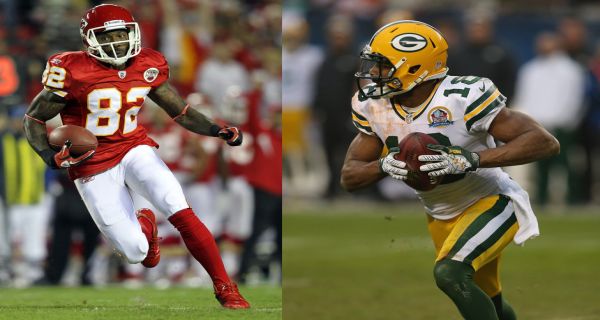
The Case for Randall Cobb by Rich Migliorisi
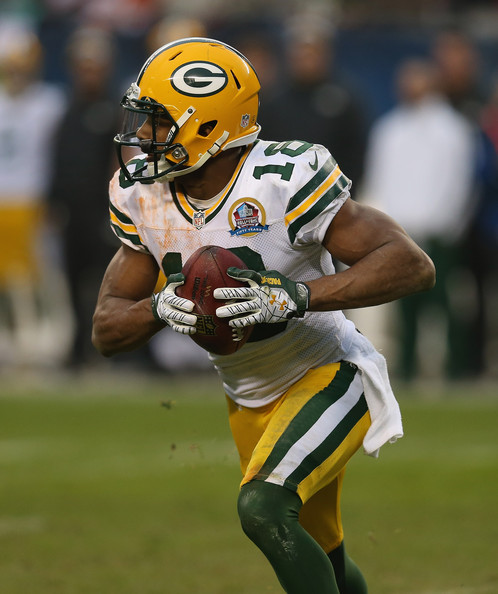
When comparing wide receivers Randall Cobb and Dwayne Bowe, there is one key element that separates the two: upside. And this element is firmly in the corner of Cobb.
Greg Jennings is out of the picture, so that is one more reason for Cobb to build off the strides he made last season. Barring injury, we can expect a floor of 75 receptions, 1,000 receiving yards, 100 rushing yards, and six to eight touchdowns. But he is capable of so much more. When Jennings came back from his injury last year, he saw a total of 40 targets in five games. Those targets will now be spread elsewhere, lending opportunity to Cobb’s playmaking ability. He is considered more explosive than Bowe, as his 5.8 yards after the catch per reception (YAC/Rec) in 2012 helps indicate (Bowe had a 3.9 YAC/Rec). As for efficiency, Cobb’s catch percentage was 78.4%, which was second in the league among wide receivers. He gives himself a chance to make the most of his targets.
Bowe may indeed be the safer selection of the two, but that doesn’t necessarily make it the right choice. The floor may be safe, but the upside is limited. He has never exceeded 1,200 receiving yards in a season. You also can’t expect him to come close to replicating the 15 touchdowns he had in 2010. He has never scored more than seven TDs in any other year. And with this being Bowe’s seventh season, I think we know what to expect. There is no reason we should foresee newly acquired quarterback Alex Smith catapult Bowe into the upper echelon of fantasy receivers.
Cobb is already capable of putting up similar numbers to those of Bowe. And if the Green Bay Packers take further advantage of Cobb’s versatility, possibly in a Percy Harvin type role, he could even challenge the marks of 1,300 yards receiving, 200 yards rushing, and double digit touchdowns. This should securely place him in the top 10 among his peers. If the third year wide-out continues to be involved in the return game, he will be an even bigger asset to leagues who score return yards and TDs. It also doesn’t hurt that he has the best quarterback in football.
Fantasy football is a win or go home game, so even at the risk of a lower floor or injury concern, I am willing to gamble on upside, and when it comes to that, Randall Cobb has the kind to help win you a title.
The Case for Dwayne Bowe by Brett Talley
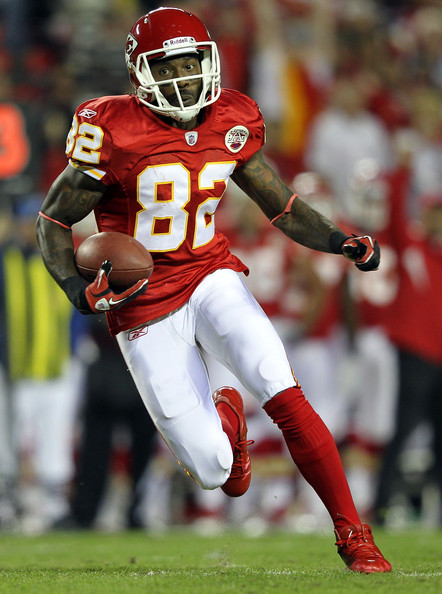
Let’s start with why I’m not a big Randall Cobb fan.
First of all, I’m not buying the narrative that the departure of Greg Jennings is a big boon to Cobb. Because Cobb lines up primarily in the slot (84.4% of the time last year), Jennings’ departure isn’t going to result in more snaps for Cobb. And all the upside that Cobb has is really dependent on him getting more snaps. Last year he led the league in points per snap, but he only played about 600 snaps and was the 58th ranked receiver in snaps played. In the games that Jennings was inactive, Cobb averaged 39 snaps per game. But in the games Jennings was active, Cobb averaged 41 snaps per game. So this idea that Jennings leaving will translate into more snaps for Cobb doesn’t make any sense.
A big reason that people love Cobb is his playmaking ability and ability to rack up yards after the catch. But the problem with relying on yards after catch is that there is very little year to year correlation in that statistic. Below is a chart showing the correlation between yards after catch per reception in 2012 and 2011 for all receivers with at least 30 receptions. You’ll see the r-squared value is 0.18. That’s not an insignificant number, but we’re looking for an r-squared above 0.50 to show a strong year-to-year correlation.
The other thing about Cobb’s playmaking abilities is that he often draws comparisons to Percy Harvin. Sure, if the Packers started using Cobb like the Vikings used Harvin when they had him, I’d like Cobb more. But they’re not going to. The Packers have a great quarterback and other good receivers. The Vikings has Christian Ponder at QB and Michael Jenkins as their second best receiver. Hoping Cobb turns into the next Harvin doesn’t seem realistic.
Let’s see, why else don’t I like Cobb? Ah yes, touchdowns.
Mike Clay of ProFootballFocus.com has an awesome new stat called tADEZ which determines the average distance from the end zone that a player was on all of his targets. The idea, and it’s a good one, is that the average distance a player is from the red zone when targeted isn’t arbitrary like red zone target data. Among players with 50+ targets last year, Cobb ranked 60th of 128 in average distance from the red zone when targeted. James Jones ranked 6th in tADEZ, and Jordy Nelson ranked 19th. It’s clear that Cobb is not the preferred target when Green Bay gets in close. So it’s hard to expect Cobb to exceed the eight touchdowns he scored last year, and it wouldn’t be surprising if he didn’t reach that mark again.
OK, now let’s turn to Bowe.
Like Cobb, Bowe’s team has made changes on offense that appear like they could help the receiver. The Chiefs have replaced Matt Cassel and Brady Quinn with Alex Smith. Cassel and Quinn combined for a 57.6% completion percentage last year and were rated the 26th and 33rd worst passers of the year by ProFootballFocus. Meanwhile, Smith led the league in completion percentage and was tied for third in yards per attempt.
I’m not trying to sell you on Smith as a top five quarterback, but I am trying to stress how big of an upgrade this is for Bowe. I’m hesitant to say that Andy Reid is a great thing for Smith and that he’s the quarterback guru some claim that he is. I’m not so sure that the guru title is factual. But I do know that Reid’s west coast scheme is similar to the ‘avoid mistakes’ system in which Smith finally thrived in San Francisco.
Bowe’s catch rate was basically in line with the completion percentage of Cassel/Quinn last year. Even if Smith is just adequate with his efficiency (say around 62% completion percentage), that could be enough to get Bowe up to 70 receptions, which would put him around the top 20 in that category. And that’s assuming he doesn’t see more targets.
With respect to Bowe lacking the yards after catch skills that Cobb has, I would again remind you that there isn’t much year-to-year correlation in that statistic. But I’d also like to point out that being able to rack up yards after catch is in no way a requirement of being an excellent fantasy receiver. Here is a list of some receivers who had fewer yards after catch per reception than Bowe last year:
Roddy White, Julio Jones, Victor Cruz, Marques Colston, Reggie Wayne, Eric Decker, and Brandon Marshall.
That’s seven of the top 15 receivers in standard scoring last year. You don’t need to be a big yards after catch guy to be a stud. So the fact that Cobb gets more yards after catch isn’t a reason to take him over Bowe.
As for Bowe’s touchdown potential, it’s considerably higher than the three he scored last year. His offense is almost unquestionably going to be better this year. How much better is certainly up for debate, but it would be almost impossible for it to be as bad as it was last year. The Chiefs scored just 18 touchdowns, which is the 4th lowest total in the last five years. Smith will help. Reid will help. And good old fashioned positive regression will help.
Bowe’s low touchdown total was a product of the offense, not a reflection on his talent. The offense will certainly rebound and Bowe will easily be the best target the team has when they get in close.
For all these reasons, I would take Bowe straight up over Cobb. But with Cobb going in the late third round on average and Bowe going in the early fifth round, there’s no doubt in my mind about who I would rather draft.


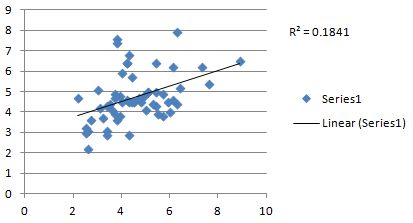
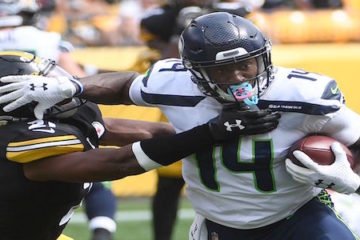
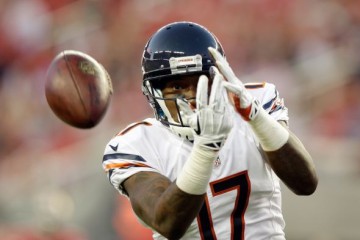
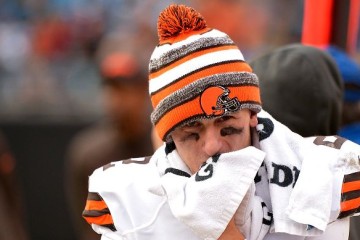
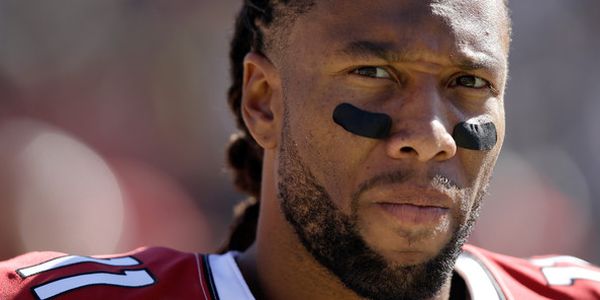
3 Comments
R-squared is not a correlation coefficient, it is a measure of how well the data points fit a straight line. The correlation is the the slope of the line. Eyeballing the graph shows that the correlation for YAC is around .37, which is generally considered to be a moderate correlation coefficient (0.30 is moderate, 0.50 is strong).
Well duh, everybody knows that.
Not the writer of this article apparently.